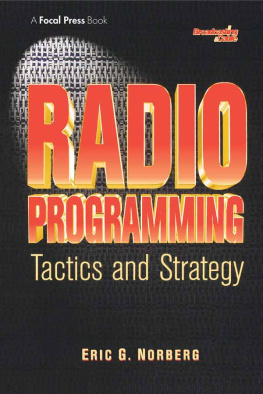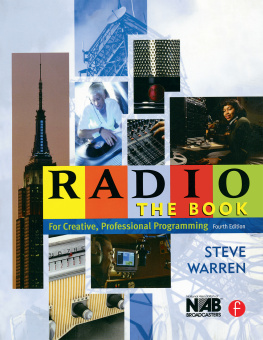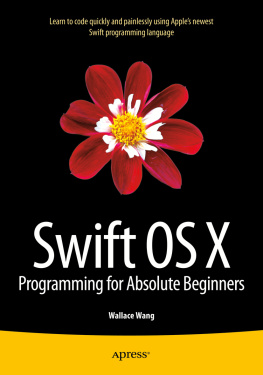Radio Programming:
Tactics and Strategy
Broadcast & Cable Series
Series Editor: Donald V. West, Editor/Senior Vice-president,
Broadcasting & Cable
Global Television: How to Create Effective Television for the 1990s
Tony Verna
The Broadcast Century: A Biography of American Broadcasting
Robert L. Hilliard and Michael C. Keith
Global Telecommunications: The Technology, Administration and Policies
Raymond Akwule
Selling Radio Direct
Michael C. Keith
Electronic Media Ratings
Karen Buzzard
International Television Co-Production: From Access to Success
Carla Brooks Johnston
Practical Radio Promotions
Ted E. F. Roberts
The Remaking of Radio
Vincent M. Ditingo
Winning the Global Television News Game
Carla Brooks Johnston
Merchandise Licensing for the Television Industry
Karen Raugust
Radio Programming: Tactics and Strategy
Eric G. Norberg
Radio Programming
Tactics and Strategy
Eric G. Norberg

First published 1996 by Focal Press
Published 2016 by Routledge
2 Park Square, Milton Park, Abingdon, Oxon 0X14 4RN
711 Third Avenue, New York, NY 10017, USA
Routledge is an imprint of the Taylor & Francis Group, an informa business
Copyright 1996 Taylor & Francis
All rights reserved. No part of this book may be reprinted or reproduced or utilised in any form or by any electronic, mechanical, or other means, now known or hereafter invented, including photocopying and recording, or in any information storage or retrieval system, without permission in writing from the publishers.
Notices
Practitioners and researchers must always rely on their own experience and knowledge in evaluating and using any information, methods, compounds, or experiments described herein. In using such information or methods they should be mindful of their own safety and the safety of others, including parties for whom they have a professional responsibility.
Product or corporate names may be trademarks or registered trademarks, and are used only for identification and explanation without intent to infringe.
Library of Congress Cataloging-in-Publication Data
Norberg, Eric G.
Radio programming: tactics and strategy / by Eric G. Norberg.
p. cm.(Broadcasting & cable series)
Includes index.
ISBN-13: 978-0-240-80234-3 (pbk)
1. Radio programsPlanning. I. Title. II. Series.
| PN1991. 55. N67 1996 | 95-50768 |
791. 440236dc20 | CIP |
British Library Cataloguing-in-Publication Data
A catalogue record for this book is available from the British Library.
To my wife, friend, assistant, and partner,
Jane Kenney-Norberg
Contents
As a student, teacher, writer, and, especially, practitioner of radio from 1960 to the present, Ive read many books on modern radio programming. Many have seemed interesting and well written, but to date every book Ive read has presented techniques of programming radio stations that amount to how I do it. Many of the points made are useful and will work when applied, but generally they must be applied as the author dictates in order to work.
My purpose in writing this book is to present the principles by which modern radio programming is constructed. Although I do give examples to clarify points, generally speaking Im dealing with underlying principles only, and I encourage you to find your own unique approach using these principles. For programmers who are not yet confident enough in their skills to program contrary to the way that everybody else is doing it, these principles will help you understand why the stations you are copying do succeed. It will also help you grasp which of their techniques might not be useful for you to use and which may be relevant to your own market situation.
Radios role in our culture is unique, and unless the fundamentals of what make it so are explored and understood, we cannot succeed with it in the future. This, then, is the first radio programming handbook Im aware of that actually deals with radio programming tacticsa complete guide to the strategies underlying the creation of the magic that allows radio to be the most powerful medium of communication ever invented.
Two factors combine to create radios power. The first is that radio can be consumed while the listener is doing something else. All other forms of mass communication require the consumers focused attention before communication can occur. Radio has evolved into a personal companiona soundtrack accompaniment to our livesas a result of this unique characteristic.
The second trait of radio that contributes to its power is that the technology by which it reaches the listener is uniquely invisible. When we read, we absorb the authors thoughts, but we are still aware that we are scanning symbols on a page. When we watch television or a movie, we can get lost in a good story or follow a well-articulated thought, but we are never unaware that we are watching a reproduction on a screen. In each case, the means of communication itself forms a subtle barrier between us and the author or participants. When we listen to radio, however, the original voice, the music as it was created, reaches us through transparent technology. We do not hear the sound of the loudspeaker other than as pure sound. This allows us to respond in a more fundamentally personal way to what we hear than is possible with any other form of communication, in all of which the medium itself always becomes part of the message.
Further amplifying radios power is something called the transactional analysis principle. I once read a best-selling book about this called Born to Win. To summarize the essence of it for our discussion, I can distill it to this: People respond to us as we present ourselves to them. People react to us in the same way we act toward them. This is true in any context, but in radio this principle is uniquely effective because when others see us, part of the way we present ourselves to them includes such irrelevancies as what we look like, what weve chosen to wear, an unnoticed food stain on our sleeve, and the complexities of body language. In radio, all of these are absent, and all thats left of us is our voice. Through training, practice, and attitude, we are able to control fully the way our voice touches listeners. In radio, the rapport between us and our listeners can be completeand intense.
A number of years ago, in a TV Guide article, a university professor said that two-thirds of all spoken communication is nonverbal. At first, I rejected this idea because it seemed to suggest that television is much more effective at communicating than radio, which I knew to be untrue. (Actually, the reverse is the case.) However, after a little thought, I realized what the man really meant, and I had to agree with him. His point was that 70 percent of all communication is other than simply the words spoken, and that is true. The way we say them, the attitude we project, is what really communicates what the words are saying. Because of the transparency of the medium, radio can communicate in this way far better than all other media.
When we speak on the radio, we are speaking intimately to just one person. If we want that person to relate to us, to care who he or she is listening to, to pay attention to what we say, and to act on it, we must drop our own personal defenses and relate to our listener as we would to a close friend. Personality, in radio, consists of no more than this, and over the years, I have come to understand that everybody is capable of being a personality. The tough part for many people is realizing thatwhatever their own secret demonsthey are nonetheless just like everyone else, and they are likable people. Therefore, we must let the listener experience us as we really are.













